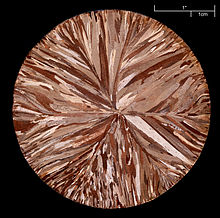- Industrial etching
-
For other uses, see Etching (disambiguation).
 Etched in ferric chloride for PCB production at home
Etched in ferric chloride for PCB production at home
In industry, etching, also known as chemical milling, is the process of using acids, bases or other chemicals to dissolve unwanted materials such as metals, semiconductor materials or glass. This process has been used on a wide variety of metals with depths of metal removal as large as 12mm (0.5 in). Selective attack by the chemical reagent on different areas of the workpiece surfaces is controlled by removable layers of material called masking or by partial immersion in the reagent. It has applications in the printed circuit board and semiconductor fabrication industries. It is also used in the aerospace industry to remove shallow layers of material from large aircraft components, missile skin panels, and extruded parts for airframes.
Contents
History
The process is known to have been used by craftsmen in Europe in the middle ages, where it was applied to the decoration of armour. One such craftsman, Daniel Hopfer (circa 1470-1536) of Augsburg, Germany, is credited with being the first person to apply the method to printmaking.
Process
Wet etching
- Residual stresses in the part are removed prior to the machining process to prevent warping after the chemical milling process.
- To ensure good adhesion between the masking and part, the part undergoes a thorough degreasing and cleaning process. There needs to be good adhesion between the masking and the part to ensure uniform material removal during the milling process.
- The masking material is applied to the surfaces of the part to prevent etching from taking place on these surfaces. Some masking types include tapes or paints which are referred to as maskants. Other maskants which are commonly used as well are elastomers (rubber and neoprene) and plastics (polyvinyl chloride, polyethylene, and polystyrene).
- Masking which covers areas of desired etching can be removed by utilizing the scribe-and-peel technique.
- The exposed surfaces of the part are etched by the reagent. The machining process is affected by the temperature and the agitation of the reagent in the tank. A good removal rate requires careful consideration of these two parameters.
- After machining, the masking is removed and the parts are washed thoroughly to prevent further etching by residual reagent.
- The etched part can be further machined by other finishing operations.
Photochemical etching
Main article: Photochemical machiningThis process is very similar to wet etching except that a photoresist is used instead of maskant.
Common etchants
copper made by continuous casting, macro etched
- For aluminium
- For steels
- hydrochloric and nitric acids
- ferric chloride for stainless steels
- Nital (a mixture of nitric acid and ethanol, methanol, or methylated spirits for mild steels.
2% Nital is common etchant for plain carbon steels.
- For copper
- cupric chloride
- ferric chloride
- ammonium persulfate
- ammonia
- 25-50 % nitric acid.
- hydrochloric acid and hydrogen peroxide
- For silica
- hydrofluoric acid (HF) is a very efficient etchant for silicon dioxide. It is however very dangerous if it comes into contact with the body.
Commonly etched metals and alloys
The following metals and alloys are commonly etched using ferric chloride:
- Aluminum
- Brass
- Copper
- Beryllium-Copper
- Nickel
- Nickel Silver
- Phosphorus-Bronze
- Carbon Steel
- Stainless Steel - 300 Series, 400 series
- Spring Steel
- Zinc
- Monel
- PH15-7
- PH17-7
- Alloy 42
- Kovar
Etching in the semiconductor industry
-
Main article: Etching (microfabrication)
Etching is used widely to manufacture integrated circuits and Microelectromechanical systems. In addition to the standard, liquid-based techniques, the semiconductor industry commonly uses plasma etching.
See also
- Etching (art), for printmaking and related uses
- Electroetching
External links
-
References
Categories:
Wikimedia Foundation. 2010.

